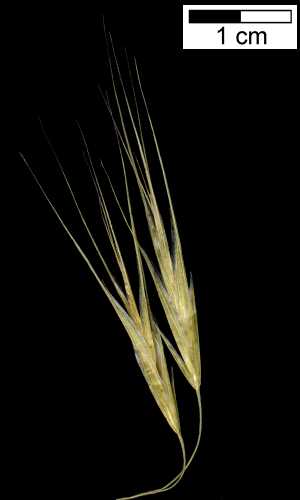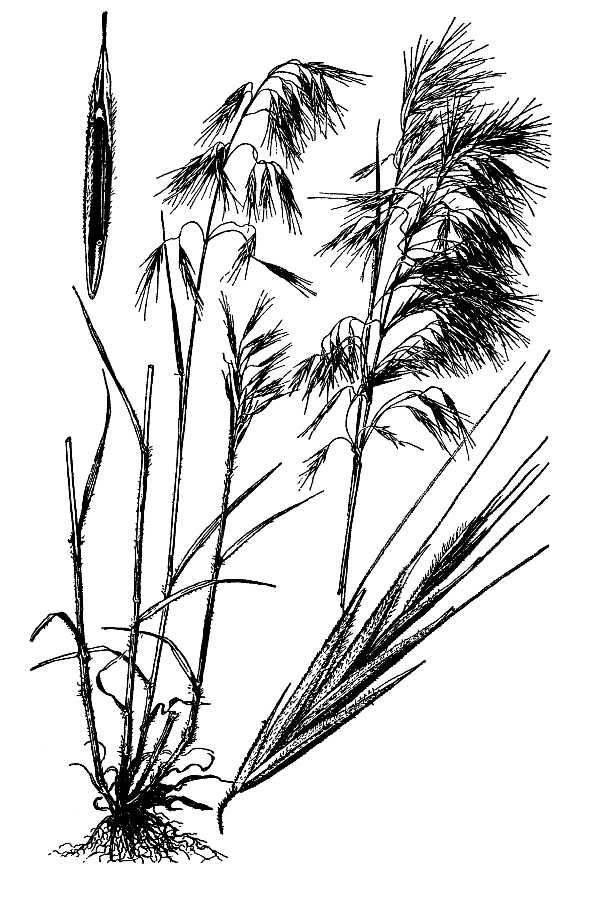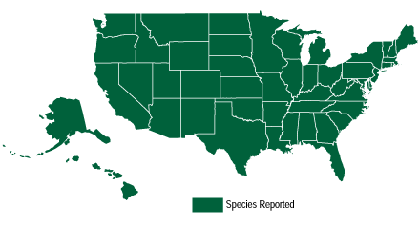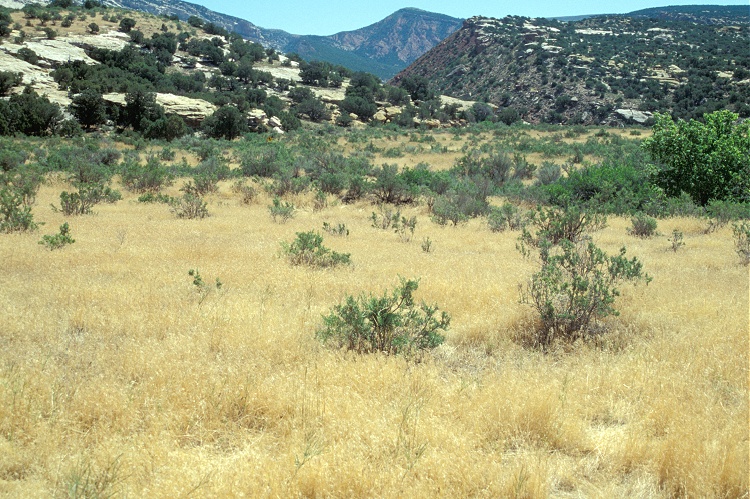
Scientific Name: Bromus tectorum L. (syn. Anisantha tectorum)
 Classification:
Classification:
Phylum or Division: Magnoliophyta
Class: Liliopsida
Order: Cyperales
Family: Poaceae
Identification: Cheatgrass is an annual grass
that can reach anywhere from 6 to 24 inches tall, depending on growth
environment. When they emerge, leaves can be distinguished by
being thin and very hairy. At maturity, leaves flatten and turn
purplish-tan, reaching about 2 to 6 inches in length. The ligule
is a prominent membrane with a long frayed margin, and no auricle is
present. Stems are smooth, erect, and many-branched at the base,
while rooting is generally shallow and fibrous. Once it has
flowered, cheatgrass can be identified by its long (2 to 6 inches),
slender panicle with numerous spikelets that droops to one side.
Awns are slender and straight, attached to brown, hairy, narrow and
fluffy seeds (1/2 inch long).
Cheatgrass is easily
confused with a number of other introduced brome grasses in the United
States, most notably Japanese brome (Bromus japonicus). Japanese
brome can be distinguished by having a twisted awn and shorter seed
than cheatgrass.
Original Distribution: B. tectorum is native to the Mediterranean, i.e. southern Europe, southwestern Asia, and northern Africa.
Current
Distribution: Cheatgrass has
followed the
development of cattle farming since the domestication of cattle, mostly
due to
suitably disturbed ecological conditions created by overgrazing.
Cheatgrass can now be found throughout Europe, southern
 Site
and Date of Introduction: Because B. tectorum
was introduced and became invasive in
Site
and Date of Introduction: Because B. tectorum
was introduced and became invasive in
Mode(s) of Introduction: Since cheatgrass began to appear in the western United States simultaneous with the expansion of cropping and other agriculture, it seems reasonable to suppose that cheatgrass was probably introduced in impure seed, although this is speculation. It was intentionally planted in some areas.
Reason(s)
Why it has Become Established: Intermontane
areas of the
American west had been isolated from intensive use until the 1850s and
the
advent of the gold and silver rushes. Cattle were driven to and
from
mines, and the previously ecologically isolated areas became important
cattle
ranching areas. Cattle trails led to localized intensive
overgrazing.
Likewise, cattle were introduced into the Great Basin in the 1860s when
valuable ores were discovered in parts of
While the
establishment of cheatgrass in
the western plains was almost certainly facilitated by the introduction
of
livestock, its persistence and success also depends on another factor:
fire. Many of the shrubby areas that
have been converted to cheatgrass
monocultures originally had a long fire cycle of about 60 to 110 years
in some
areas and about 30 to 50 in others. Variation in this fire cycle
allows
heterogeneity in the establishment of native perennials. However,
the
unique growing cycle of cheatgrass has completely altered fire
cycles.
Cheatgrass has a life cycle such that it is regarded as a winter
annual.
It seeds in late summer and germinates in fall. Its seedlings
over winter
and those that survive have the advantage in spring of having hearty
root and
photosynthetic systems while other species are establishing.
Early in the
season, cheatgrass produces above-ground biomass sooner and in greater
bulk
than its competitors, so that as it dries after seeding in summer
before the
autumn rains. This creates large quantities of fuel during the
dry
season. Moreover, it is distributed more
continuously than native vegetation, guaranteeing the faster spread of
fire in
addition to increased frequency. Thus, cheatgrass can reduce the
time
between fire events to as little as 10 years, effectively decimating
its native
competitor’s chances of success.
Benefit(s): Given the level of disturbance and damage to ecosystems during the latter half of the 19th century which continues today, it seems unlikely that ecosystems that have now been taken over by B. tectorum would have been able to recuperate given the lack of native bunch grasses. While the need for cheatgrass in such a situation is undoubtedly unfortunate, it seems almost more reasonable to site habitat/ecosystem destruction as the demise of the shrub-steppe ecotype rather than the establishment or spread of cheatgrass. Cheatgrass may have actually rescued landscapes from erosion and other types of degradation, as intended by those who intentionally introduced cheatgrass into the intermontane western
 Threat(s): B. tectorum
is a well-established, possibly even
integrated, part of may areas of the intermontane western plains.
Nonetheless, there do remain some areas in which native
shrub-steppe
vegetation persists which merit protecting. Control
of cheatgrass could therefore yield some native
ecosystem
conservation. However, there is some
question as to how competitive cheatgrass actually is when natural
ecosystem
processes have not been severely disturbed by cattle ranching.
Thus, the
conservation of the remnants of shrub-steppe ecosystem seems to mandate
a more
ecosystem-oriented approach.
Threat(s): B. tectorum
is a well-established, possibly even
integrated, part of may areas of the intermontane western plains.
Nonetheless, there do remain some areas in which native
shrub-steppe
vegetation persists which merit protecting. Control
of cheatgrass could therefore yield some native
ecosystem
conservation. However, there is some
question as to how competitive cheatgrass actually is when natural
ecosystem
processes have not been severely disturbed by cattle ranching.
Thus, the
conservation of the remnants of shrub-steppe ecosystem seems to mandate
a more
ecosystem-oriented approach.Economically, cheatgrass does present material threats to both cattle ranching and wheat farming. While cheatgrass can be a fair grazing grass early in the season before it has flowered, its value as forage decreases significantly later in the season after it has seeded. Moreover, its long, fine awns can actually injure cattle, horses, and other grazing animals. Wheat fields, on the other hand, often become infested with cheatgrass, which significantly reduces crop yields and thus economic output.
Control Level Diagnosis: Highest Priority
Despite the fact that cheatgrass has become an integral and probably inevitable part of many ecosystems, its economic and potential further ecosystem threats are such that it should be an important priority in invasive species control. It is perhaps the economic argument that is most compelling, however. Because cheatgrass is so pervasive, any efforts at control it would need to be biological and ecosystem oriented to be cost-effective.
Control Method: A variety of innovative approaches to the control of B. tectorum exist, most of which involve targeting particular environmental preferences of the grass rather than more traditional chemical and physical removal methods, although these are still employed. In general, these strategies pertain directly to the agricultural type under treatment:
1. Cattle - reducing grazing pressures in an attempt to allow the regeneration and recuperation of native perennial plants may help mitigate the problems associated with cheatgrass in rangelands.
2. Wheat - crop rotation has been suggested as an effective mechanism for cleansing land of cheatgrass infestation. For instance, corn, grain sorghum, proso millet, and sunflower are substantially better spring competitors than wheat and may be able to succeed even when cheatgrass invasion is intense.
Similar techniques are
suggested to
rehabilitate non-agricultural lands. Because cheatgrass
germinates
immediately upon seed release, its seeds do not store or hibernate
well.
Therefore, if other plants or grasses can out compete cheatgrass
for a
number of years, it seems possible that this might effectively cleanse
an area
of its infestation. Planting
References:
Brooks, M.L., C.M. D'Antonio, D.M.
Richardson, J.B. Grace, J.E. Keeley, J.M. DiTomaso, R.J. Hobbs, M.
Pellant, and D. Pyke. 2004. The effects of invasive alien
plants on fire regimes. Bioscience
54: 677-688.
Carpenter, A.T. and T.A. Murray.
2004. Bromus tectorum (http://tncweeds.ucdavis.edu/esadocs/documnts/bromtec.html).
Element Stewardship Abstract and Wildland Weeds Program, The Nature
Conservancy, UC Davis.
Cox, G.W. 1999. Alien species in North America and Hawaii.
Island Press: Washington, DC. Pages 127-141.
D'Antonio, C.M. and P.M. Vitousek.
1992. Biological invasions by exotic grasses, the grass/fire
cycle, and global change. Annual
Review of Ecology and Systematics 23: 63-87.
Humphrey, L.D. and E.W. Schupp.
2004. Competition as a barrier to establishment of a native
perennial grass (Elymus elymoides)
in alien annual grass (Bromus tectorum)
communities. Journal of Arid
Environments 58: 405-422.
Klein, R.A., G.A. Wicks, and D.J. Lyon.
2002. Downy brome control (http://ianrpubs.unl.edu/Weeds/g422.html).
Institute of Agriculture and Natural Resources, University of Nebraska,
Lincoln.
Knapp, P.A. 1996. Cheatgrass (Bromus tectorum L) dominance in
the Great Basin Desert: history, persistence, and influences of human
activities. Global
Environmental Change 6: 37-52.
Mack, R.N. 1981. Invasion of Bromus tectorum L into western
North America: an ecological chronicle. Agro-Ecosystems 7: 145-165.
Mack, R.N. and D.A. Pyke. 1983.
Demography of Bromus tectorum: variation in time and
space. Journal of Ecology
71: 69-93.
Saskatchewan Agriculture, Food, and Rural
Revitalization. 2000. Downy brome: an increasing weed
problem in Saskatchewan (http://www.agr.gov.sk.ca/Crops).
SAFRR, Government of Saskatchewan, Canada.
USDA, NRCS. 2004.
The PLANTS Database, Version 3.5 (http://plants.usda.gov).
Young, J. Bromus tectorum (http://ucce.ucdavis.edu/datastore/detailreport.cfm?usernumber=21&surveynumber=182). California Invasive Plant Council.
Photo credits:
2. <http://www2.uni-jena.de/biologie/spezbot/Bestimmungshilfen/Bromus/Bromus_tectorum_Aehre.htm>
3. <https://www.denix.osd.mil/denix/Public/ES-Programs/Conservation/Invasive/rangelands.html>
4. The Invasive Species Iniciative, Wildland Weeds Program, The Nature Conservancy, UC Davis.
5. USDA-ARS-NPA. Great Plains Research Unit. Downy brome plants in wheat. <http://infosys.ars.usda.gov/Weeds/Brome/sld004.htm> Courtesy of Dr. Phil Westra, Colorodo State U.
